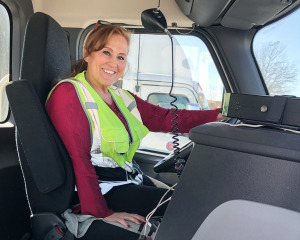Subscriber Benefit
As a subscriber you can listen to articles at work, in the car, or while you work out. Subscribe Now
Julia Hogan spent the first decades of her professional life as a journalist, a blogger and a comedy club bartender. But when the pandemic struck, she found herself mostly unemployed.
“I decided it was probably time for me to do a hard pivot,” Hogan said.
Actually, it was an extremely hard pivot. About a year ago, the 53-year-old Indiana University graduate (with an English degree) started driving big rigs for Anderson-based Carter Express. And she hasn’t looked back.
“I didn’t want to be 75 and think, ‘It would have been really cool to have been a truck driver,’” she said.
Current national trends seem to indicate that many other women are having similar thoughts—and that trucking companies, still recovering from a catastrophic driver shortage that helped hobble national supply chains during the pandemic, are happy to have them.
Today, women account for 8.1% of all truck drivers in the United States, up from 4.9% 20 years ago, according to the U.S. Bureau of Labor Statistics.

“Companies are seeking out women for driver roles and other positions throughout the trucking industry,” said Jennifer Hedrick, president and CEO of the Women in Trucking association.
That influx has begun to reshape the character of the profession. Trucking still conjures up images of bearded men hitting the open road for days on end, jawing on their CB radios and sleeping in their rigs at dicey-looking highway rest stops. For multiple reasons, however, this stereotype doesn’t particularly appeal to many aspiring female truckers. Which is why trucking firms are working to (where possible) make their work less unpredictable and time-consuming.
“Women who pursue careers as drivers are often wearing multiple hats and balancing different roles and responsibilities, so they want flexibility,” Hedrick said. “If a woman needs or wants to be home in the evening for caregiving or other commitments, she can be. That wasn’t always the case historically, with many days and weeks spent on the road.”
Because most clients of Hogan’s employer, Carter Express, are within a day’s roundtrip drive, the firm has attracted a fair number of truckers who have a family or an elderly parent to care for. Those are often women.
And these days, Carter Express is recruiting women in a more focused way.

“We’ve always had a respectable amount of women drivers, but in the last several years, we’ve made a more conscious effort to show that we are a supportive environment for women in all roles in the industry,” said Jessica Warnke, president and CEO of Carter Express. “I think we’ve been lucky in the types of routes and freight that we have. It’s friendly to women drivers.”
By “friendly” she means that, instead of long hauls that keep drivers away from home for days and require them to find often-sketchy places to spend their nights, many of Carter’s routes are regular, daily “milk runs” that allow their employees to show up at the same time every day, haul an already-loaded trailer to its destination and go home.
Hogan doesn’t have it quite that easy, but her schedule is still fairly predictable. She’s what’s called a “board runner,” meaning she typically covers routes that don’t have other takers. She drives about 500 miles each day, but usually ends those days back at home.
“My dispatcher will call me on a Thursday or Friday, and she will give me a choice of maybe five or six routes that are available the next week,” she said. “Then I pick one, and my route will be the same every day that week.”
Less demanding
Indianapolis-based Venture Transport (the trucking division of the logistics company Venture Logistics) offers a similar route structure, which also gives it a leg up with female recruits.

“With our freight, the majority of our drivers are home every night,” said Andrew Kellick, the company’s executive director of driver experience. “The majority of our freight is ‘drop and hook,’ which means the drivers don’t unload anything at their stops. They drop a trailer, pick up another, and move on to their next stop.
“Also, a lot of our freight is ‘dedicated,’ which means the drivers are always going to the same locations. They get to know the people there, and it’s a more comfortable atmosphere, as opposed to not knowing where you’re going when you start your day.”
Kellick estimates about 12% to 13% of Venture’s drivers are female.
It should be noted, however, that male drivers appreciate less-demanding scheduling as much as women. Which is why more and more companies are trying to move in that direction. In Kellick’s view, all freight lines must work harder to attract high-quality candidates of either sex during a tight labor market. If that happens to make a company “female-friendly,” then so much the better.
Carter Express takes on absolute newcomers to the industry and will sometimes cover their tuition as they study to acquire a commercial driver’s license, or CDL. The company typically follows this up with in-house training plus pairings on their first trips with more-seasoned operators. Venture, on the other hand, prefers to hire already-licensed drivers with (at least) a modicum of experience.
“We push heavily for driver referrals, because those tend to be our best hires,” Kellick said. “Our great female drivers are referring their female-driver friends. And the freight that we haul matches with what a lot of those female drivers are looking for.”

Venture driver Cheryl Belville left behind a 31-year retail career to become a trucker.
“I felt I needed a change, and trucking seemed like an adventure for me,” said Belville, who’s driven for 12 years. “I’m an adventurous person, so I thought, ‘I’m going to go to truck driving school and see if I can do this.’ And here I am.”
She’s a “dedicated” driver, running the same 463-mile route pretty much every workday. She starts at her home base of Fort Wayne, drives to Upper Sandusky, Ohio, then to Lafayette and back to Fort Wayne.
“I leave Fort Wayne at 3:30 a.m.,” Belville said. “I work about a 10-hour day. I have a really, really sweet run.”
Back when she joined the profession, she was sometimes the only female in the room. But that’s changing, she said.
“People are more accepting of it now,” Belville said. “And actually, I think statistically that women are safer drivers. Don’t tell anybody, but I think we are.”
Safer drivers
Actually, it’s not a secret. According to a 2018 study by the American Transportation Research Institute, the average female driver is 20% less likely to be in a crash than her male counterparts.
“On average, women are less likely to take risks, which makes them safer drivers than most men,” added a report from U.S.-based freight exchange service DAT Freight & Analytics. “Women truck drivers also tend to possess stronger multitasking and organizational skills and are also strong communicators with qualities like patience and the ability to focus for long periods of time, all of which make them a great fit for truck driving.”
This certainly tracks with both Belville and Hogan. Warnke at Carter Express said Hogan’s rig (like many others in the firm’s fleet) is equipped with monitors that document less-than-optimal driver behavior, allowing the company to keep a safety “score.” The higher the score, the more problems the driver has. Hogan, Warnke said, has for the last several weeks maintained a score of 0. And Belville has won her company’s Driver of the Month award multiple times and also had her skills recognized by the Indiana Motor Trucking Association.
“Female drivers are safer, exercise more caution and take fewer risks in their driving, compared to their male counterparts,” Hedrick said. “This, of course, leads to fewer accidents and safer roads for us all.”
While both Belville and Hogan say they got into trucking out of a desire for change and a need to answer the siren call of the open road, the pay was also an extremely important factor. According to the industry website Truckers Report, the average salary of an Indiana CDL truck driver is $80,509 per year, or $1,548 per week. Truckers willing to put in extra miles and time can bring in well north of $100,000.
With such salaries on offer, experts in the field think the number of women in the trucking industry will only increase. Not just behind the wheel, but in other positions throughout the ground logistics sector.
“There are deliberate efforts to hire women, not necessarily to address a driver shortage, but to bolster the number of women in the trucking profession across roles such as drivers, technicians, supply chain management and in the C Suite,” Hedrick said. “Companies are committed to increasing gender diversity in trucking and across the transportation sector generally.”
For her part, Hogan has grown so comfortable in her profession that she’s thinking about getting a CB radio soon.
“When I first started driving a few months ago, I didn’t want to get one,” she said. “I didn’t want to hear people make fun of my backing skills.”•
Please enable JavaScript to view this content.

